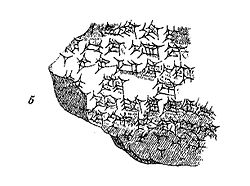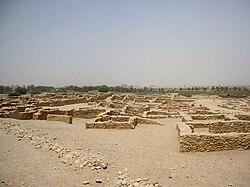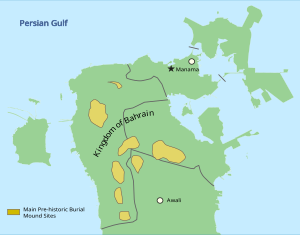Dilmun
Marhashi and Meluhha. | |
| Location | Eastern Arabia |
|---|---|
| Region | Northern Governorate |
| Type | Ancient |
| Part of | Eastern Arabia |
| History | |
| Founded | c. late 4th millennium BC[1] |
| Abandoned | c. 538 BC[2] |
| Periods | Bronze Age |
Dilmun, or Telmun,
The great commercial and trading connections between Mesopotamia and Dilmun were strong and profound to the point where Dilmun was a central figure to the Sumerian creation myth.[14] Dilmun was described in the saga of Enki and Ninhursag as pre-existing in paradisiacal state, where predators do not kill, pain and diseases are absent, and people do not get old.[14]
Dilmun was an important trading centre. At the height of its power, it controlled the Persian Gulf trading routes.[1] According to some modern theories, the Sumerians regarded Dilmun as a sacred place,[15] but that is never stated in any known ancient text. Dilmun was mentioned by the Mesopotamians as a trade partner, a source of copper, and a trade entrepôt.
The Sumerian tale of the garden paradise of Dilmun may have been an inspiration for the Garden of Eden story.[16][17][18]
History

Dilmun was an important trading center from the late fourth millennium to 800 BC.[1] At the height of its power, Dilmun controlled the Persian Gulf trading routes.[1] Dilmun was very prosperous during the first 300 years of the second millennium BC.[24] Dilmun was conquered by the Middle Assyrian Empire (1365–1050 BC), and its commercial power began to decline between 1000 BC and 800 BC because piracy flourished in the Persian Gulf. In the 8th and 7th centuries BC the Neo-Assyrian Empire (911–605 BC) conquered Dilmun, and in the 6th century BC the Neo-Babylonian Empire, and later the Achaemenid Empire, ruled Dilmun.
The Dilmun civilization was the centre of commercial activities linking traditional agriculture of the land—then utterly fertile due to artesian wells that have dried since, and due to a much wetter climate—with maritime trade between diverse regions such as the
One of the earliest inscriptions mentioning Dilmun is that of king Ur-Nanshe of Lagash (c. 2300 BC) found in a door-socket: "The ships of Dilmun brought him wood as tribute from foreign lands."[26]
Kingdom of Dilmun

From about 2050 BC onward, Dilmun seems to have had its heyday.
From about 1720 BC, a decline is visible. Many settlements were no longer used, and the building of royal mounds ceased. The Barbar Temple fell into ruins.
Dilmun under foreign rule

It seems that, at least from 1500 BC, Dilmun was under the rule of the Akkadian-speaking Mesopotamian
There are other Assyrian inscriptions during the first millennium BC, indicating Assyrian sovereignty over Dilmun.[2] One of the early sites discovered in Bahrain suggests that Sennacherib, King of Assyria (707–681 BC), attacked northeast Arabia and captured the Bahraini islands.[32] The most recent reference to Dilmun came during the Neo-Babylonian Empire; Neo-Babylonian administrative records, dated 567 BC, stated that Dilmun was controlled by the King of Babylon. The name of Dilmun fell from use after the collapse of Babylon, in 538 BC, with the area henceforth identified as Tylos during the Hellenistic period.[2]
The "Persian Gulf" types of circular, stamped (rather than rolled) seals known from Dilmun—that appear at
Copper ingots from Oman and bitumen (which occurred naturally in Mesopotamia) may have been exchanged for cotton textiles and domestic fowl, major products of the Indus region that are not native to Mesopotamia. Instances of all of these trade goods have been found. The importance of this trade is shown by the fact that the weights and measures used at Dilmun were¡ in fact, identical to those used by the Indus, and were not those used in Southern Mesopotamia.
In regards to copper mining and smelting, the
Some Meluhhan vessels may have sailed directly to Mesopotamian ports but, by the Isin-Larsa Period, Dilmun monopolized the trade. The Bahrain National Museum assesses that its "Golden Age" lasted ca. 2200–1600 BC. Discoveries of ruins under the Persian Gulf may be of Dilmun.[34]
People, language and religion
The population used
Mythology

In the early epic Enmerkar and the Lord of Aratta, the main events, which center on Enmerkar's construction of the ziggurats in Uruk and Eridu, are described as taking place at a time "before Dilmun had yet been settled".
Dilmun, sometimes described as "the place where the sun rises" and "the Land of the Living", is the scene of some versions of the Sumerian creation myth, and the place where the deified Sumerian hero of the flood, Utnapishtim (Ziusudra), was taken by the gods to live forever. Thorkild Jacobsen's translation of the Eridu Genesis calls it "Mount Dilmun" which he locates as a "faraway, half-mythical place".[40]
Dilmun is also described in the
For Dilmun, the land of my lady's heart, I will create long waterways, rivers and canals, whereby water will flow to quench the thirst of all beings and bring abundance to all that lives.
Ninlil, the Sumerian goddess of air and south wind had her home in Dilmun.[citation needed]
However, it is also speculated that
Location of Dilmun


In 1987, Theresa Howard-Carter proposed that Dilmun of this era might be a still unidentified tell near the Arvand Rud (Shatt al-Arab in Arabic) between modern-day Quanah and Basra in modern-day Iraq.
As of 2022, archaeologists have failed to find a site in existence during the time from 3300 BC (Uruk IV) to 556 BC (Neo-Babylonian Era), when Dilmun appears in texts. According to Hojlund, no settlements exist in the Gulf littoral dating to 3300–2000 BC.
Garden of Eden theory
In 1922, Eduard Glaser proposed that the Garden of Eden was located in Eastern Arabia within the Dilmun civilization.[45] Scholar Juris Zarins also believes that the Garden of Eden was situated in Dilmun at the head of the Persian Gulf (present-day Kuwait), where the Tigris and Euphrates Rivers run into the sea, from his research on this area using information from many different sources, including Landsat images from space. In this theory, the Bible's Gihon would correspond with the Karun in Iran, and the Pishon River would correspond to the Wadi al-Batin river system that once drained the now dry, but once quite fertile central part of the Arabian Peninsula.[46]
Known rulers
Only a few rulers of the Dilmun kingdom are known:[47]
- Ziusudra (27th century BC)
- Rimun (c. 1780 BC)
- Yagli-El, son of Rimun
- Sumu-lěl (c. 1650 BC)
- Usiananuri, grandfather of Uballissu-Marduk (precise dates unknown)
- Burnaburiash II and Kurigalzu II)
- Operi (c. 710 BC)
- Hundaru I (c. 650 BC)
- Qena (c. 680–c. 670 BC)
- Hundaru II (706–685 BC)
See also
- Bahrain National Museum
- DHL International Aviation ME, a cargo airline using "Dilmun" as radio call sign
- Dilmun Burial Mounds
- Gerrha
- Gilgamesh
- History of Bahrain
- History of Kuwait
- Indus–Mesopotamia relations
- Kuwait National Museum
- Uruk
References
- ^ .
- ^ ISBN 978-0-226-46905-8.
- ^ The former is the reconstructed Sumerian pronunciation; the latter is the reconstructed Semitic.
- ^ a b Transliteration: "CDLI-Found Texts". cdli.ucla.edu.
- ^ a b Similar text: "CDLI-Found Texts". cdli.ucla.edu.
- ^ Smith, Sylvia (2013-05-21). "Bahrain digs unveil one of oldest civilizations". BBC News. BBC.
- ^ a b "Qal'at al-Bahrain – Ancient Harbour and Capital of Dilmun". UNESCO. Retrieved 17 August 2011.
- ^ Harriet E. W. Crawford (1998). "Dilmun and Its Gulf Neighbors". p. 9.
- ^ "The Invention of Cuneiform: Writing in Sumer". Jean-Jacques Glassner. 1990. p. 7.
- ^ Archived at Ghostarchive and the Wayback Machine: "Kuwait's archaeological sites reflect human history & civilizations (2:50 – 3:02)". Ministry of Interior News.
- JSTOR 41223078.
- ^ "The Archaeology of Kuwait" (PDF). Cardiff University. pp. 5–427.
- ^ "Prehistory and Protohistory of the Arabian Peninsula: Bahrain". M. A. Nayeem. 1990. p. 32.
- ^ a b The Arab world: an illustrated history p.4
- ISBN 978-1-134-49263-3., page 230
- ^ Edward Conklin. Getting Back Into the Garden of Eden. p. 10.
- ^ ISBN 978-0-8122-1047-7. Retrieved 21 May 2017.
- ISBN 978-0-226-45238-8.
In fact, there is some reason to believe that the very idea of a paradise, a garden of the gods, originated with the Sumerians.
- ^ a b Louvre Pouysségur, Patrick , ed. "Perforated Relief of King Ur-Nanshe." Louvre Museum. Louvre Museum. Web. 13 Mar 2013.
- ^ CDLI Wiki University of Oxford, 14 Jan 2010. Web. 13 Mar 2013.
- ISBN 978-0-429-72638-5.
- ^ "tablet". British Museum.
- ^ Transcription: "CDLI-Archival View". cdli.ucla.edu.
- ^ "Dilmun and Its Gulf Neighbours". Harriet E. W. Crawford. 1998. p. 152.
- ISBN 978-0-521-58348-0.
- ^ Samuel Noah Kramer (1963). The Sumerians: their history, culture, and character. p. 308.
- ^ ISBN 978-87-93423-16-9, pp. 381
- ^ Steffen Terp Laursen: Kings of Dilmun identified by name; [1] Kings of Dilmun identified by name and announced in a press conference held by BACA
- ISBN 978-87-93423-16-9, pp. 388–390
- ISBN 978-87-93423-16-9, pp. 428–430
- ISBN 978-87-93423-16-9, pp. 390
- ISBN 978-0-7007-1098-0.
- ^ "Egypt's Making: The Origins of Ancient Egypt 5000–2000 BC". Michael Rice. 1991. p. 229.
- ^ Page, Lewis. "Lost ancient civilisation's ruins lie beneath Gulf, says boffin". www.theregister.com.
- ISBN 9781315511153.
- ISBN 9781136155314.
- ISBN 978-88-86-71206-4.
- ISBN 9781136155314.
- S2CID 239256795.
- ISBN 978-0-300-07278-5. Retrieved 2 July 2011.
- ISBN 978-0-226-45238-8.
- ISBN 978-0-415-14416-2. Retrieved 31 May 2011.
- S2CID 163963264.
- ^ Roads of Arabia p.180
- S2CID 170465632.
- ^ Hamblin, Dora Jane (May 1987). "Has the Garden of Eden been located at last?" (PDF). Smithsonian Magazine. 18 (2). Archived from the original (PDF) on 9 January 2014. Retrieved 8 January 2014.
- ^ Legrain, 1922; Cameron, 1936; The Cambridge History of Iran; Hinz, 1972; The Cambridge Ancient History; Majidzadeh, 1991; Majidzadeh, 1997.
External links
- Indus Valley—Mesopotamian trade passing through Dilmun
- Lost ancient civilisation's ruins lie beneath Gulf, says boffin
- Bahrain National Museum's hall of Dilmun
- Dilmun Site Al-Khidr, Failaka Island, State of Kuwait
- Greek inscriptions found on Bahrein (a pdf-file)
- Dilmun Calendar Theory Backed, Gulf Daily News, 11 July 2006


